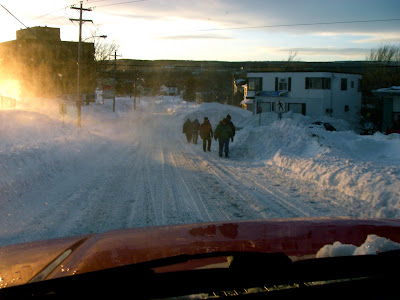Sea Kayaking "Iceberg Alley"

This beautiful Iceberg was grounded off of Ferryland Head in late June two years ago...just less than an hours drive south of St. John's.
This is a very interesting time of the year in this part of the world. This part of the world being where the cold Labrador current runs along our east coast. Over the winter, ice forms in the sea off of Labrador. The current from the north continually pushes this forming ice further south, helping to contribute to what ice has formed off the northern part of the island of Newfoundland.

Depending on the year, many factors dictate how much ice will form, and how far south it will reach, as well as whether that ice will lie onshore, or be pushed offshore. As for Icebergs, some have been breaking off of glaciers in parts of northern Canada, but over 90% of them come from Greenland. Once broken off from Greenland, these Icebergs usually travel this northern sea for up to three years. Many over winter in northern Labrador, but eventually get pushed south by the Labrador current, some coming with these ice flows, as yet others will come later in the season being released as the pack ice breaks up in late spring. This usually leads to Icebergs being along our coast from now until late May, but in some years of heavy ice, we may see Icebergs along our shore line until mid July...sometimes even later. Whether we will have a year with lots, or little Iceberg activity, is determined by to many factors to accurately predict. Factors include the amount of calving from Greenland in preceding years, ice formation in Labrador, currents, on or offshore winds...as well as air temperature and sunshine, which will all contribute to the rate of an iceberg's melt. How big was the iceberg to start with, as well as how many pieces it has broken up into, to form even more smaller icebergs.

As for photographing or even sea kayaking around these huge beautiful sculptures of nature....the ideal year would be one that brings large Icebergs into shore, just to have them ground fast to the ocean bottom in a bay or cove. That would leave them handy to reach by seakayak, as well as view from a hike along the shore. Best thing then would be to have the winds turn around from the west to give us warm weather and sunshine to view these gorgeous spectacles, as they continue to melt and change shape daily. Mother nature at her finest. While we usually always get Icebergs each year, I have only seen a few years that were as perfect as just described. We'll just have to wait and see what this season brings.

Some years before I finally took up sea kayaking, I photographed this paddler in late March, off of St. Phillip's, with pack ice and Bell Island off in the background. This is only minutes from home in downtown St. John's.








